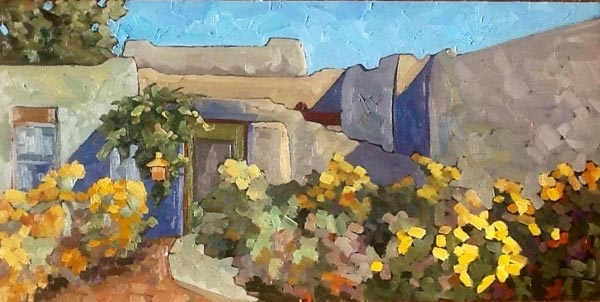
Barbara Clark paints in oil, but it’s her pastel past that helps make her paintings so different. How?
In a pastel workshop in 2006, Barbara Clark learned from Susan Ogilvie to make her own substrate. The grounds she subsequently prepared for her pastel pieces were black or otherwise very dark. When Clark began expanding into plein air painting, with oils, she found herself fairly intimidated. “Plein air is a big challenge for me,” she says. “It was very frustrating in the beginning. I needed a comfort level, so I painted on black because that’s what I’m used to.”

“Earth & Sky,” by Barbara Clark, oil, 6 x 12 in.
The tone for her panel is actually a mixture of alizarin crimson and French ultramarine, and perhaps a dash of viridian, which makes a purplish black. Clark has found that the coolness and dark value of the ground can be used strategically to create depth in a painting.

“Southwest Jewels,” by Barbara Clark, pastel, 18 x 36 in. Studio piece based on the plein air piece “Southwest Jewels”
The New Mexico artist has a personal style that often leaves a bit of the dark ground visible in between fields or strokes of pure color. “I’m trying to mass in the largest shapes I can get away with, with one or two strokes,” says Clark. “I don’t blend on the canvas if at all possible. I’m looking for something that’s fresh.”

“Foothills Puzzles,” by Barbara Clark, 2015, oil, 9 x 12 in.
Her focus is on color temperature. “Everyone is different — I think the temperature is more important than the hue,” she says. “I would rank it as temperature, then value, then hue. I’m not classically trained, so I don’t know all the rules. I’ll use a color straight from the tube. Bold, upfront, honest — you can’t separate the art from the artist.”

The scene Clark was painting in “Foothills Puzzles”
Clark uses the black outlines around color in her paintings to create depth — she eliminates them in the background of paintings so that the contrast of the outlines in the foreground pulls those elements forward. It makes sense, in a way. In a part of the country where even distant rocks are warm, an artist very concerned with color temperature will respect that fact and find another way to make elements come forward or recede. “The landscape is so warm that it needs to recede using some other method,” she says.

“North Beach Corrales,” by Barbara Clark, 2014, oil, 10 x 20 in.
The dark ground urges Clark to do something else that is generally avoided by artists. She puts the highlight — the lightest light of the painting — in first. “I often use highlights as the benchmark to know where everything is in the painting,” she says. “I’m setting the value scale that way. It helps me find my way around the painting.”

“The Courthouse,” by Barbara Clark, 2014, oil, 6 x 12 in.
Finally, she tends to use oil paints to execute plein air studies, from which she will choose the most appropriate to expand into larger pastel pieces in the studio. Everything is logical, considering Clark’s past as a pastelist. Still, the artist realizes that her work could be seen by some as unconventional. “I’m thrilled when people like it because when I look at it I think, ‘Wow, that person is really crazy and disturbed,'” Clark says with a laugh. “But I’m honored that people like it. I want to connect with people, so I’m thrilled that this approach resonates with someone.”




